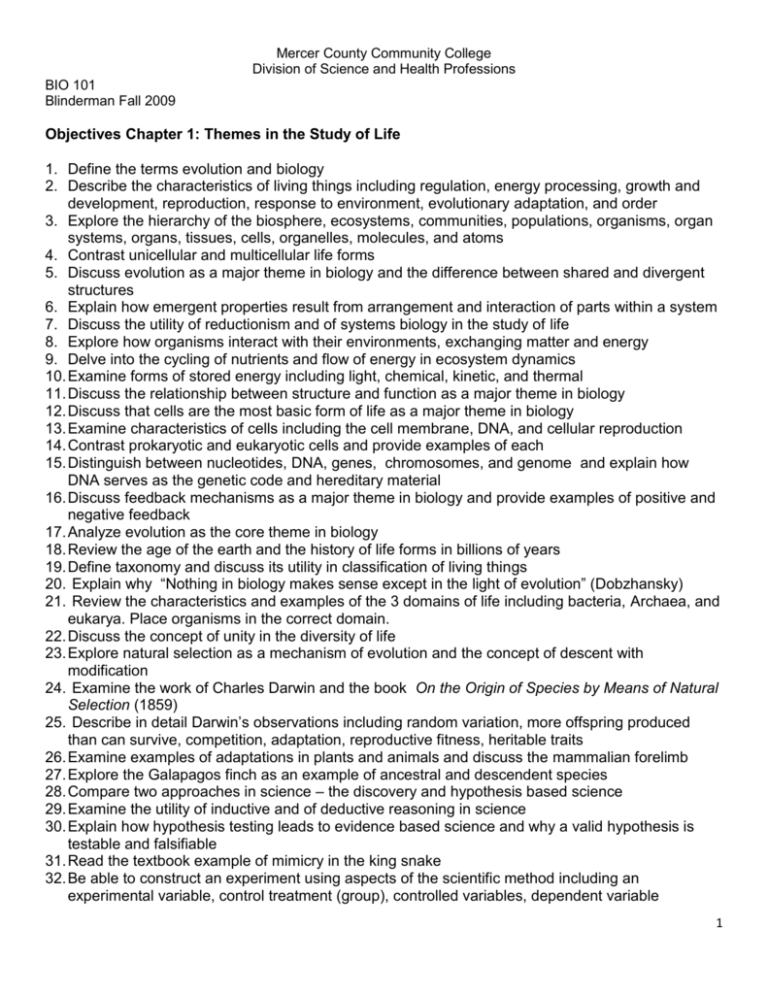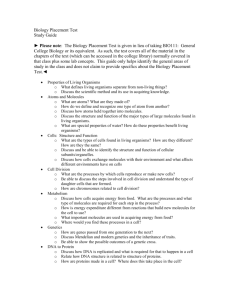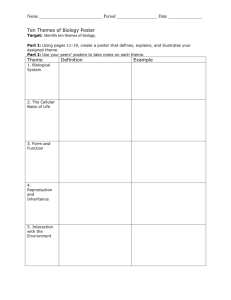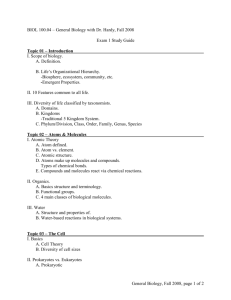Mercer County Community College Division of Science and Health
advertisement

Mercer County Community College Division of Science and Health Professions BIO 101 Blinderman Fall 2009 Objectives Chapter 1: Themes in the Study of Life 1. Define the terms evolution and biology 2. Describe the characteristics of living things including regulation, energy processing, growth and development, reproduction, response to environment, evolutionary adaptation, and order 3. Explore the hierarchy of the biosphere, ecosystems, communities, populations, organisms, organ systems, organs, tissues, cells, organelles, molecules, and atoms 4. Contrast unicellular and multicellular life forms 5. Discuss evolution as a major theme in biology and the difference between shared and divergent structures 6. Explain how emergent properties result from arrangement and interaction of parts within a system 7. Discuss the utility of reductionism and of systems biology in the study of life 8. Explore how organisms interact with their environments, exchanging matter and energy 9. Delve into the cycling of nutrients and flow of energy in ecosystem dynamics 10. Examine forms of stored energy including light, chemical, kinetic, and thermal 11. Discuss the relationship between structure and function as a major theme in biology 12. Discuss that cells are the most basic form of life as a major theme in biology 13. Examine characteristics of cells including the cell membrane, DNA, and cellular reproduction 14. Contrast prokaryotic and eukaryotic cells and provide examples of each 15. Distinguish between nucleotides, DNA, genes, chromosomes, and genome and explain how DNA serves as the genetic code and hereditary material 16. Discuss feedback mechanisms as a major theme in biology and provide examples of positive and negative feedback 17. Analyze evolution as the core theme in biology 18. Review the age of the earth and the history of life forms in billions of years 19. Define taxonomy and discuss its utility in classification of living things 20. Explain why “Nothing in biology makes sense except in the light of evolution” (Dobzhansky) 21. Review the characteristics and examples of the 3 domains of life including bacteria, Archaea, and eukarya. Place organisms in the correct domain. 22. Discuss the concept of unity in the diversity of life 23. Explore natural selection as a mechanism of evolution and the concept of descent with modification 24. Examine the work of Charles Darwin and the book On the Origin of Species by Means of Natural Selection (1859) 25. Describe in detail Darwin’s observations including random variation, more offspring produced than can survive, competition, adaptation, reproductive fitness, heritable traits 26. Examine examples of adaptations in plants and animals and discuss the mammalian forelimb 27. Explore the Galapagos finch as an example of ancestral and descendent species 28. Compare two approaches in science – the discovery and hypothesis based science 29. Examine the utility of inductive and of deductive reasoning in science 30. Explain how hypothesis testing leads to evidence based science and why a valid hypothesis is testable and falsifiable 31. Read the textbook example of mimicry in the king snake 32. Be able to construct an experiment using aspects of the scientific method including an experimental variable, control treatment (group), controlled variables, dependent variable 1 Mercer County Community College Division of Science and Health Professions BIO 101 Blinderman Fall 2009 33. Provide in an experiment and explanation of how data is to be obtained 34. Discuss the limitations of science 35. Contrast between a hypothesis and a theory in science Objectives Chapter 2: The Chemical Context of Life Read about the link between formic acid in ants and the maintenance of the “Devils Gardens” Contrast the following terms and concepts: matter, element, compound Examine the elements essential to life including CHON Provide an example of a trace element important in normal body functioning Examine an atom and its subatomic particles – proton, neutron, electron Discuss the use of radioactive isotopes Examine an experiment (textbook) on the use of tritiated thymidine in determining optimal temperature for cell growth 8. Distinguish between a structural and molecular formula 9. Compare and contrast covalent, ionic, hydrogen, and Van der Waal types of bonding. Provide examples of each. 10. Explain the importance of molecular structure with respect to function and provide an example 11. Analyze a chemical reaction to determine reactants and products. Examine the chemical reaction of photosynthesis 12. Discuss reaction reversibility and chemical equilibrium 1. 2. 3. 4. 5. 6. 7. Objectives Chapter 3: Water and the Fitness of the Environment 1. Discuss the importance of water as a medium for life on Earth and with respect to cellular content 2. Explain how water as a polar molecule forms hydrogen bonds 3. Describe in detail how the following properties of water support life: cohesion (and surface tension), temperature moderation (including kinetic energy, heat, temperature, specific heat, and calories), and water as a solvent 4. Discuss the ability of water to retain and release heat and the application to cells, lakes, and oceans 5. Describe the effects of evaporative cooling 6. Explore water as a solvent including the definitions of solute, solvent, hydrophilic, hydrophobic, and aqueous and colloidal solutions 7. Define pH, examine the pH scale, and provide examples of acids, bases, and neutral substances 8. Provide an example of a reaction involving a buffer and explain why buffers are essential to living organisms 9. Examine acid precipitation, its causes and effects 10. Describe the “greenhouse effect” and its association with global warming, rising sea levels, reduction of ozone, ecosystem changes, disease, and acidification of the ocean (including effects on coral reefs) 2 Mercer County Community College Division of Science and Health Professions BIO 101 Blinderman Fall 2009 Objectives Chapter 4: Carbon and the Molecular Diversity of Life 1. 2. 3. 4. 5. 6. 7. 8. 9. Examine the ability of carbon to form complex and diverse molecules Contrast organic with inorganic molecules Discuss Stanley Miller’s experiment on the synthesis of organic molecules Provide examples of organic molecules Analyze the bonding of carbon atoms with hydrogen, oxygen, and nitrogen atoms View varying carbon chain lengths of molecules Provide a definition and examples of hydrocarbons Define isomer and provide examples of isomers Recognize 7 functional groups of organic molecules including hydroxyl, carbonyl, carboxyl, amino, sulfhydral, phosphate, methyl 10. Examine the structure and function of the ATP molecule Objectives Chapter 5: Structure and Function of Large Biological Molecules 1. Identify the 4 classes of large biomolecules 2. Distinguish between a monomer and a polymer 3. Describe the synthesis and breakdown of polymers using the terms enzyme, condensation, dehydration, hydrolysis 4. Outline the classification of carbohydrates including simple sugars, disaccharides, starches, monomers, polymers 5. Discuss the importance of glucose, starch, cellulose, glycogen, and chitin in living organisms 6. Describe categories of lipids including fats (saturated, unsaturated, partially hydrogenated, and triglycerides), steroids (including cholesterol) and phosopholipid 7. Explain the importance of phosopholipid structure to cell membranes 8. Provide examples of the functions of various proteins 9. Discuss the function and characteristics of enzymes 10. Explain how amino acids join to form polypeptides and the relationship between genetic code and primary structure 11. Examine the structure of the 20 amino acids 12. Examine the primary, secondary, tertiary, and quaternary structures of proteins and provide sickle cell disease as an example of structure and function relationship 13. Explain why protein denaturation affects protein function and how denaturation can occur 14. Define: DNA, RNA, nucleotide, polynucleotide, gene 15. Analyze nucleotide structure to identify nitrogenous base, pentose sugar, and phosphate group 16. Explore the linkage between sugar and phosphate in a DNA strand to form a backbone 17. Explore the hydrogen bonding between complementary DNA bases A:T and G:C 18. Distinguish between purine and pyrimidine nucleotide bases 19. Examine the DNA double helix and the cell’s ability to replicate the nucleotide sequence 20. Discuss the use of DNA sequence in the elucidation of evolutionary relatedness between living things 3







